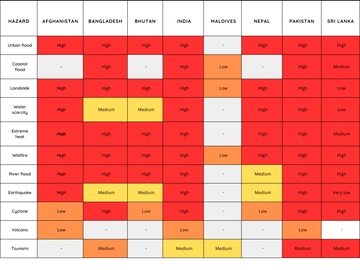Climate Risks in South Asia
With another cup of coffee on the table, Tashi reclines back in his chair. Lalima has her elbow resting on the table and is eager to learn more. Tashi pulls out his smartphone and opens a link in the browser.
"Take a look at this. This tool shows the level of impact of disasters. The tool highlights the likelihood of different natural hazards affecting countries (very low, low, medium, and high). Based on this, I summarized the level of hazards in South Asian countries in a table. Let me open the document."

Tashi leans forward and opens a document on his smartphone and shows it to Lalima:
"So, for urban floods, a high hazard level means that potentially damaging and life-threatening hazards are expected to occur at least once in the next 10 years. While medium hazard means that there is more than 20% probability that the urban floods will occur in the coming 10 years and low hazard means that there is a 1% probability. However, the conditions for high, medium, and low may change from one hazard to another."

Table 1: Hazard levels in South Asia

"Wow! There are a lot of risks categorized as ‘high’ in the table."

Lalima takes a closer look and quickly grabs a tissue and a pen.
"Hmmm, let me see. So, seven countries have high urban flood risks in South Asia and seven out of eight countries have high wildfire risks. Then, six countries have high extreme heat, river floods, and landslide risks. This is an eye-opener."

"Exactly! And there’s more."

To use the tool that guides how to reduce the impact of these hazards and to find more information: ThinkHazard!
Average Rating: ☆ ☆ ☆ ☆ ☆ (0 reviews)

